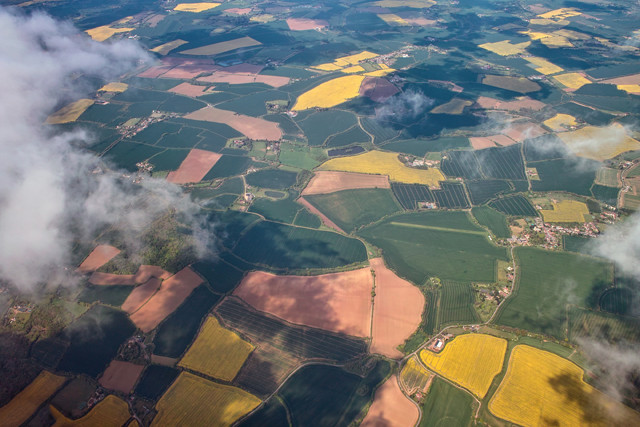
by Fred Schwab Tuesday, January 15, 2019

Credit: Adobe stock photo/Petar
In 1940, after traveling across America from Oklahoma to New York City, Woody Guthrie wrote the iconic folk song “This Land Is Your Land.” He had quickly tired of hearing Kate Smith’s 1938 rendition of Irving Berlin’s “God Bless America” blaring from jukeboxes along the route and regarded that song’s portrayal of America as a land of equality for all as misleading. Guthrie thought that corporations and the wealthy disproportionately owned or controlled too much private property, according to a 2012 NPR report. Guthrie felt that lower- and middle-class folks needed a reminder that America belonged just as much to them as to the ultrarich and powerful, and he drafted “This Land” as a protest song. In fact, the song was originally titled “God Blessed America for Me,” a sarcastic rejoinder to Berlin’s tune. Countless renditions of “This Land” have cultivated the song into what many contend is a second national anthem.
But who really does own the land in America? The land surface area of the United States is 9.8 million square kilometers, about 6 percent of the global total. Two to 3 percent of that is Native American land. The rest is subdivided as follows, according to a Congressional Research Service report in 2017:
(1) Private Land: Roughly 61 percent of U.S. land is, indeed, privately owned, with the extremely wealthy and corporate America leading the way. The single largest private landowner in the U.S. is John Malone, the billionaire chairman of cable company Liberty Media Corp., who owns 8,900 square kilometers.
(2) State Land: About 9 percent of our land area is owned and managed by state governments and is not “ours” per se, though much is public land. The management, preservation and development of state-owned land are largely at the discretion of individual state governments.
(3) Federal Public Land: We, the American people, collectively, are the fourth-largest landowners on Earth, via the U.S. federal government. We own 2.6 million square kilometers, slightly more than one-fourth of the U.S. land surface. Each of us has a personal stake, and voice, in how these lands are managed, maintained, enjoyed and otherwise used.
The percentage of private versus public (including both federal and state) lands varies regionally. Most land in the East and Great Plains is privately owned: 94 percent in Maine, and 97 percent in Nebraska, for example. The West tells a different tale: just 4 percent of Alaska land is private, with the rest public; 12 percent of Nevada is private, with the rest public. Even in populous California, more than half of land is publicly owned.
Our land’s caretakers are federal agencies, part of either the Department of Agriculture or the Department of the Interior. Public lands are managed through four federal systems: The U.S. Forest Service cares for the National Forest System (31.3 percent of the property); the Bureau of Land Management administers the National System of Public Lands (39.6 percent of public lands); the National Park Service handles the National Park System (13.6 percent of public lands); and the U.S. Fish and Wildlife Service handles the National Wildlife Refuge System (15.5 percent of public lands).
The budgets, workforces and policies for managing our public lands are subject to the whims of the executive and legislative branches of the federal government. These are, in turn, sensitive to our votes and voices, via our pens, phones and computers, which therefore play an important role in preserving, protecting, developing and enjoying our property. Insights into how to exercise this influence are documented in a recent book by Ken Ilgunas, “This Land Is Our Land” (2018). He reviews the long history of land ownership as well as European views about “freedom to roam” even on privately held land, and he suggests specific steps we can take to reclaim freedom to wander across our land.
Of course, viewpoints differ about the proper use, development and access to our lands and the alleged “sanctity of private property.” Active lobbying efforts are waged on Congress and the legislatures and administrations of local and state governments by various entities as well as individuals. Mining corporations, energy companies, ranchers, farmers and agricultural corporations have starkly different voices and objectives than environmental groups like the Sierra Club and Wilderness Society.
We the people, however, have the ultimate power to pick and choose whose voices and views we wish to strengthen. It is imperative that we do so if we wish to guarantee, for ourselves and future generations, that this land was truly made for you and me. Guthrie said it best with the following original verses not usually included in recordings:
As I was walkin’ – I saw a sign there And that sign said – no trespassin’ But on the other side … it didn’t say nothin! Now that side was made for you and me! In the squares of the city – In the shadow of the steeple Near the relief office – I see my people And some are grumblin’ and some are wonderin’ If this land’s still made for you and me.
© 2008-2021. All rights reserved. Any copying, redistribution or retransmission of any of the contents of this service without the expressed written permission of the American Geosciences Institute is expressly prohibited. Click here for all copyright requests.